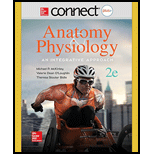
Concept explainers
Examining the superficial anatomic markings and internal body structures as they relate to the covering skin is called
- a. regional anatomy.
- b. surface anatomy.
- c. pathologic anatomy.
- d. comparative anatomy.
Introduction:
The study of forms and structure is known as Anatomy. It is derived from “anatomy” the Greek word which means to dissect. The scientists who study the forms and structure of organisms are known as anatomists.
Answer to Problem 1DYKB
Correct answer:
Surface anatomy is the superficial anatomic marking and internal body structures as they relate to skin covering. Therefore, option b. is correct.
Explanation of Solution
Reason for the correct statement:
Option b. is given as “surface anatomy”. The Gross anatomy is the part of the anatomy that deals with the investigation of “structure and relationship of parts of the body that are visible” such as stomach, heart, kidney, brain. This may be approached in several ways which include systemic anatomy, regional anatomy, surface anatomy, comparative anatomy, and embryology. Surface anatomy focuses both on internal structure and superficial anatomical marking that relates to the skin covering them. Hence, surface anatomy is one of the several approaches that examine both internal structure and superficial anatomical marking that relates to skin that covers them.
Hence, option b. is correct.
Reasons for the incorrect statements:
Option a. is given as “regional anatomy”. It examines all of the structure that is present in the particular region of the body as a unit. Hence, option a. is incorrect
Option c. is given as “pathologic anatomy”. It examines the anatomical changes resulting from disease. Hence, option c. is incorrect.
Option d. is given as “comparative anatomy”. It examines the differences and similarities between anatomies of different species. Hence, option d. is incorrect.
Hence, options a., c., and d. are incorrect.
The branch of anatomy that examines both internal structure and superficial anatomical marking that relates to skin that covers them is known as surface anatomy.
Want to see more full solutions like this?
Chapter 1 Solutions
Connect Access Card for Anatomy & Physiology
- Plekhg5 functions in bottle cell formation, and Shroom3 functions in neural plate closure, yet the phenotype of injecting mRNA of each into the animal pole of a fertilized egg is very similar. What is the phenotype, and why is the phenotype so similar? Is the phenotype going to be that there is a disruption of the formation of the neural tube for both of these because bottle cell formation is necessary for the neural plate to fold in forming the neural tube and Shroom3 is further needed to close the neural plate? So since both Plekhg5 and Shroom3 are used in forming the neural tube, injecting the mRNA will just lead to neural tube deformity?arrow_forwardWhat are some medical issues or health trends that may have a direct link to the idea of keeping fat out of diets?arrow_forwardwhat did charles darwin do in sciencearrow_forward
- fa How many different gametes, f₂ phenotypes and f₂ genotypes can potentially be produced from individuals of the following genotypes? 1) AaBb i) AaBB 11) AABSC- AA Bb Cc Dd EE Cal bsm nortubaarrow_forwardC MasteringHealth MasteringNu × session.healthandnutrition-mastering.pearson.com/myct/itemView?assignment ProblemID=17396416&attemptNo=1&offset=prevarrow_forward10. Your instructor will give you 2 amino acids during the activity session (video 2-7. A. First color all the polar and non-polar covalent bonds in the R groups of your 2 amino acids using the same colors as in #7. Do not color the bonds in the backbone of each amino acid. B. Next, color where all the hydrogen bonds, hydrophobic interactions and ionic bonds could occur in the R group of each amino acid. Use the same colors as in #7. Do not color the bonds in the backbone of each amino acid. C. Position the two amino acids on the page below in an orientation where the two R groups could bond together. Once you are satisfied, staple or tape the amino acids in place and label the bond that you formed between the two R groups. - Polar covalent Bond - Red - Non polar Covalent boND- yellow - Ionic BonD - PINK Hydrogen Bonn - Purple Hydrophobic interaction-green O=C-N H I. H HO H =O CH2 C-C-N HICK H HO H CH2 OH H₂N C = Oarrow_forwardFind the dental formula and enter it in the following format: I3/3 C1/1 P4/4 M2/3 = 42 (this is not the correct number, just the correct format) Please be aware: the upper jaw is intact (all teeth are present). The bottom jaw/mandible is not intact. The front teeth should include 6 total rectangular teeth (3 on each side) and 2 total large triangular teeth (1 on each side).arrow_forward12. Calculate the area of a circle which has a radius of 1200 μm. Give your answer in mm² in scientific notation with the correct number of significant figures.arrow_forwardDescribe the image quality of the B.megaterium at 1000X before adding oil? What does adding oil do to the quality of the image?arrow_forwardarrow_back_iosSEE MORE QUESTIONSarrow_forward_ios
 Comprehensive Medical Assisting: Administrative a...NursingISBN:9781305964792Author:Wilburta Q. Lindh, Carol D. Tamparo, Barbara M. Dahl, Julie Morris, Cindy CorreaPublisher:Cengage Learning
Comprehensive Medical Assisting: Administrative a...NursingISBN:9781305964792Author:Wilburta Q. Lindh, Carol D. Tamparo, Barbara M. Dahl, Julie Morris, Cindy CorreaPublisher:Cengage Learning Medical Terminology for Health Professions, Spira...Health & NutritionISBN:9781305634350Author:Ann Ehrlich, Carol L. Schroeder, Laura Ehrlich, Katrina A. SchroederPublisher:Cengage Learning
Medical Terminology for Health Professions, Spira...Health & NutritionISBN:9781305634350Author:Ann Ehrlich, Carol L. Schroeder, Laura Ehrlich, Katrina A. SchroederPublisher:Cengage Learning





